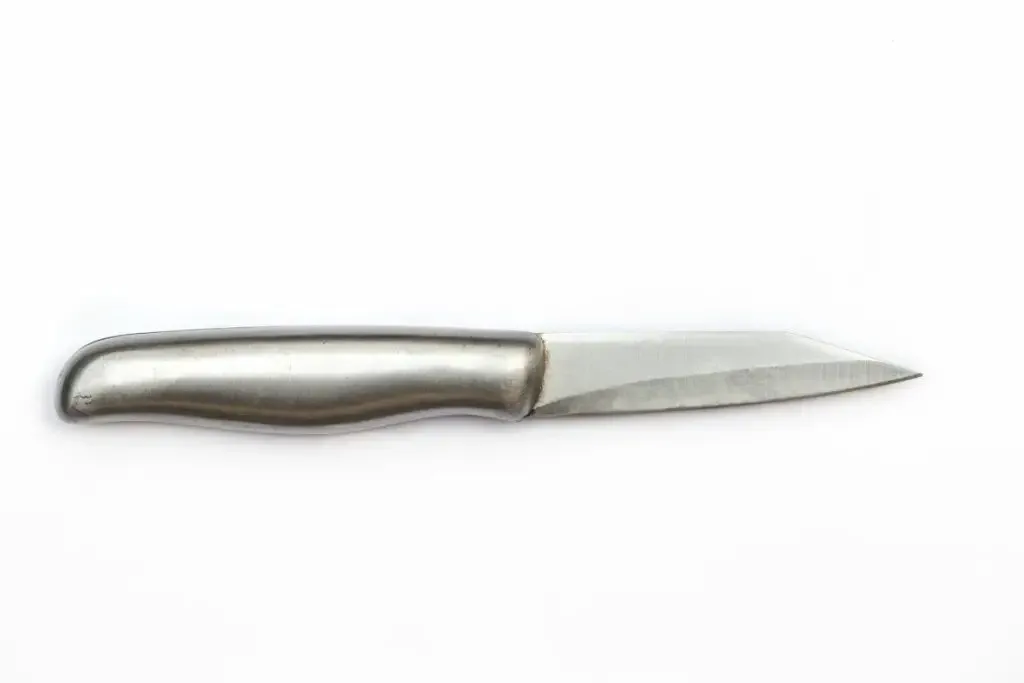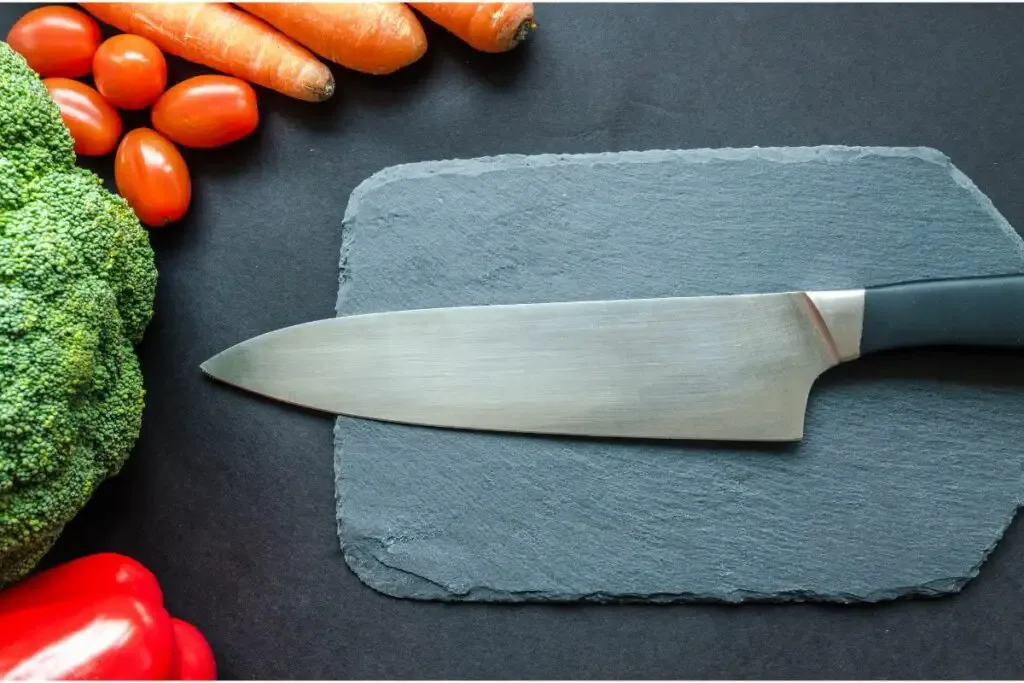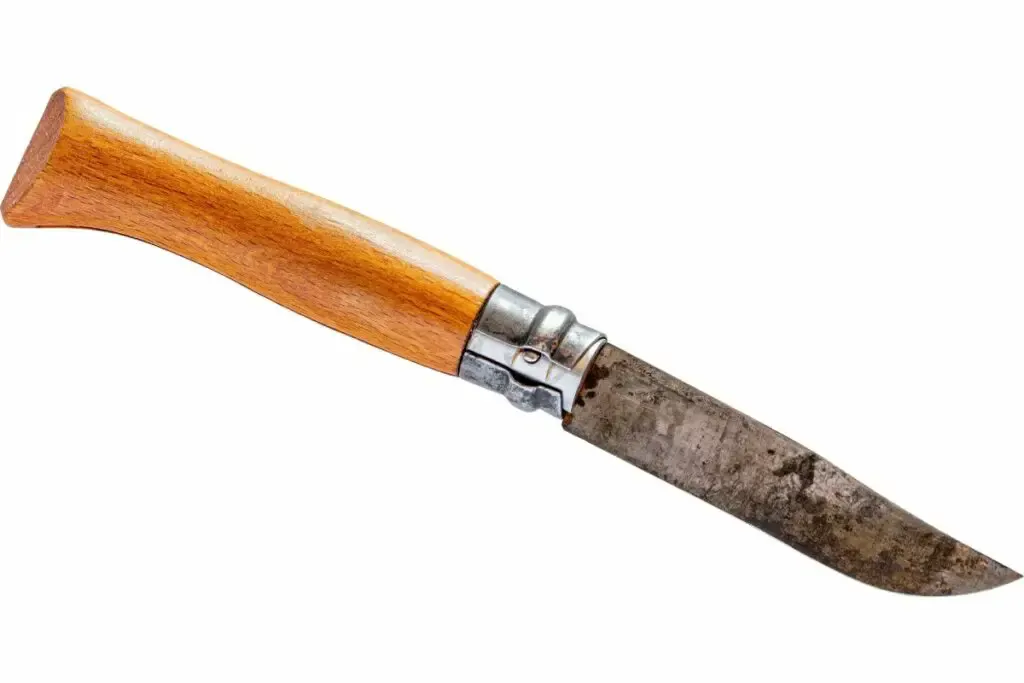As an Amazon Associate, we earn from qualifying purchases with no additional costs for you.
One may very well ask, “Why bother” when it comes to what the blade of your knife looks like. A knife that is in everyday use will get scratches on the blade. That is a given, particularly if the knife is stashed away in a drawer full of other cutlery. However, there would have to be some serious scratches, more like chips in the blade’s cutting edge, before a drop in cutting performance is likely.
The primary purpose of a knife is to cut. To do that, it must be sharp. There is little in life to some of us that is more irritating than picking up a blunt knife and trying to cut with it, particularly around the kitchen.
Removing scratches from knife blades is certainly possible. There are several ways to remove scratches from knives. These include sanding, using machinery, bead blasting, polish, baking soda, and toothpaste. Unless the scratches are severe, they can be removed.
The first rule, though, should be “function first.”A knife must be able to cut; after that, for the connoisseurs of knives comes aesthetics. We want them to look nice as well. We don’t like ugly scratches on our knife blades where there should be a nice neat surface finish, be it a mirror finish, satin finish, or any other finish.
Removing scratches from a knife blade will require a certain level of skill, some effort, some knowledge of metals, and some equipment. As always, using powered tools takes the sweat out of a task and works a whole lot quicker than just using our hands.
“But,” always that “but” in life, hey? Machines also remove material way quicker than handwork, so making a mistake and taking off too much metal is easy and can cost you dearly both in form and function. Fixing self-inflicted damage is irritating, time-consuming, and unproductive, so be careful. If you intend to use power tools, think before you grind away.
Before you mess around with looks, a good idea is to make sure you have some sharp knives around that will do the job. This is not a lesson in knife sharpening, though; here, we will be focusing on looks. For knife sharpening techniques, go to Sharpy Knives.
A Dremel tool is one of the best and most versatile power tools to remove scratches from a knife blade. Check out Dremel tools for your knife maintenance here (Amazon link).
Can You Remove Scratches From Knife Blade?

Cleaning up scratches that appear, almost by magic, on a knife blade is not an impossible task, but the cure will require time, knowledge, and effort.
An important part of the equation to consider, before you think of applying abrasive materials to your blade is what finish do you have on the knife to start with? And what are you expecting to end up with? Bear in mind that there are numerous finishes to contend with.
- Highly polished mirror finishes can be re-established relatively easily by following the gradual steps in the sanding process and ending with the polishing process.
- Satin finishes can also be re-established easily by following the process steps. One way is to clean the blade up to 2500 grit abrasive, then drop back to 2000 grit (or lower if you wish). Here, you will finish off by sanding carefully, in one direction only, not back and forth. This will render a cool, satin-smooth look.
- A titanium coating finish on your knife is great as it is totally rust-proof. A downside is that titanium is a softer metal than knife steel and will show those scratches a lot easier. Once you have sanded or ground this coating off, you are not going to be able to re-coat it again. A polished or satin finish would have to be the end here. Or just leave it alone.
- Similarly, a bead-blasted finish can only be re-established by bead blasting. Your chances of finding someone who can do this are high if you have friendly engineering-type folk in your area.
Just make sure that what you are going to end up with is what you want.
TIP: Properly storing a knife will help to reduce the risk of the knife blade becoming dull or scratched. Find out how to safely store a knife in a drawer in our article below!
Storing Knives in a Drawer: 7 Ideas How to Do It Properly
How To Remove Scratches From A Knife
A scratch on your knife blade is, for want of a better word, a dent in the metal. Eliminating that mark will necessitate the removal of knife blade material.
Even if only a microscopic amount of material needs to be removed to blend in the edges of the scratch, some metal must go. How much is entirely dependent on how deep the scratch is.
Very fine scratches or rather “dulling” can be removed, or at least improved upon, by hand, using mild abrasives such as baking soda, toothpaste, or better still, a commercial metal polish.
You would be simply polishing the blade back to its original condition. With the baking soda, you would mix up a small amount with water and make a paste.
The paste can then be rubbed on the blade using a cloth as in polishing. Don’t expect the results to be quick. It will take effort and time.
Deeper scratches can also be removed by handwork, but they are going to rely on you putting some serious elbow grease into the equation.
You would have to start the process with an abrasive wet and dry sandpaper or similar product such as carborundum water paper or emery cloth.
The coarseness of the abrasive you have to start with is determined by how bad the scratches are. For example, if you have a scratch that will really only come out with 320-grit abrasive, then you are going to spend forever getting it out by starting with a 1200-grit abrasive.
When the scratches are blended out with your starting grit, then you work up in grit size using finer and finer abrasives. For example, starting with a 320-grit, move to 600, then 1200, 1500, and 2000.
After that, a metal polish can probably take over and do the job though you could still carry on and use 2500 and 3000-grit products before you use a polishing medium.
Using a power tool is way quicker and easier than handwork, of course. Essentially you will still do all of the above but using power tools. Knifemakers essentially follow the above process as well.
At some stage, though, even the knife maker puts his power tools down and carefully hand-finishes the knife blade, using ever finer grits or compounds, until the desired effect is reached.
Right at the end, for a mirror polish, there is nothing like finishing off with a soft fabric polishing wheel and jeweler’s rouge.
TIP: A sharp knife is more important than a scratch-free blade. We have some tips to keep your knife edge sharper for longer. Read our article below to find out more!
5 Simple & Proven Tips: Keeping Your Knives Sharp Longer
Stainless Knife

Stainless steel knife blades have a much higher chrome content than carbon steel blades. This makes them more rust-resistant, especially when they are polished to a mirror finish. This finish is dazzling when new.
However, stainless steel knife material is a little bit softer than high-carbon steel knife material, and therefore the shine is dulled more easily. Simply cleaning your stainless knife can impart scratches and or dull the surface finish.
For example, many detergents used in automatic dishwashers are microscopically abrasive, and eventually, they will even dull the gloss on your ceramic crockery.
So, just using a dishwasher is almost certain to eventually dull the finish on a nice shiny stainless steel blade. Messing up that mirror finish on your knives is an easy task for a pesky dishwashing machine.
Another culprit waiting to spoil the finish of your knife would be storing it in a drawer full of other knives and cutlery. Opening and closing the drawer and rummaging around looking for the one you want ensures they bash against each other, spoiling the finish and damaging the cutting edge.
In the end, you have scratches on your knife blade, and it would be nice to remove them.
BTW: If you are interested in buying the best cutting board, you can find our recommendations below:
- The best overall: Virginia Kitchen Boys Cutting Board (Amazon link). This fantastic cutting board is made from sustainable walnut wood from the United States and brings almost perfect safety when cutting with your knives.
- Alternative: Yoshihiro Cutting Board (Amazon link). Professional traditional Japanese cutting board that chefs around the world use.
- Cheaper option: Shun Cultery Cutting Board (Amazon link). Another Japanese cutting board stands out, especially for its simplicity and affordable price.
Carbon Knife

Good knives made from carbon steel are significantly harder than similar quality “good knives” that are made from stainless steel. The difference in hardness is measurable and usually measured by the “Rockwell C scale.”
This factor, however, is a double-edged sword; excuse the pun! The higher carbon steel will have a longer-lasting cutting edge, but it will rust way more easily than those of a stainless steel knife.
Their edges can be made much sharper than stainless knives, but they are prone to dulling very quickly from rust. Continuous cleaning and oiling are required. An upside is that being tougher; the steel will not be scratched as easily as stainless steel.
In the end, removing those scratches requires the same procedure as mentioned above.
Pocket Knife

A top-quality pocket knife can usually be taken apart for cleaning, general maintenance, and lubing. Often they are put together with tiny torx head or Allan head screws. With these types of screws, to avoid damage, you must find and use the correct tools to take the knife apart.
Being able to strip the knife down will make your task of polishing up the blade a lot easier as you are not trying to work around other parts. Once done, all parts must be thoroughly washed before reassembling. The last thing you want is abrasive grit stuck in the knife.
If the pocket knife cannot be stripped down, then you have no choice but to carefully work around the other knife parts. Again, a thorough cleaning is required to remove all abrasive residue before closing up the knife. A jolly good blasting with air as a finale is definitely recommended.
Afterward, never forget to lubricate the knife a bit. A touch of light oil is ideal for the job, as you would with kitchen knives.
TIP: Find out my TOP 3 picks of pocket knives if you are interested in buying a pocket knife (Amazon link):
- Victorinox Swiss Army Rangergrip knife: Our favorite feature is the one-hand-opening lock blade, a crucial feature of this tool.
- Opinel No.8 Carbon Pocket Knife: Robust, reliable everyday carry knife, suitable for those who only want a knife blade on their pocket knife.
- Spyderco Para 3 Maxamet Pocket Knife: Lightweight knife featuring a blade made from high-performance Maxamet steel, with a full flat grind for edge durability and easy sharpening.
Conclusion
Prevention is always better than cure and easier! If you do not want scratches on your knives, wash them and dry them after every use.
Never leave any moisture on the blades that can tarnish the finish. Be sensible and store them separately from other knives, forks, spoons, etc., so they do not bash against each other.
TIP: A broken knife blade is a little more serious than some superficial scratches, but in some cases, a broken knife blade can be fixed! Read our post below to find out how!
Step-by-Step: How To Fix A Broken Knife Blade In 5 Steps
